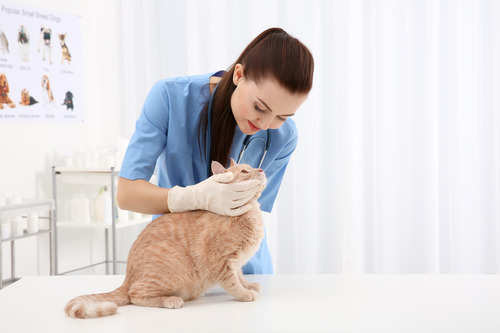Discovering a large lump on your cat can be a worrisome experience, especially when it seems to appear overnight. It’s natural to feel concerned about your cat’s health and well-being. In this article, we’ll explore possible causes, what steps you should take, and when to seek veterinary care. For personalized advice and professional care, contact Cheyenne Mountain Animal Hospital in Colorado Springs, CO, at (719) 475-1314.
Possible Causes of a Large Lump on Your Cat
There are several reasons why a large lump might suddenly appear on your cat. Understanding the potential causes can help you determine the urgency of the situation and how to proceed.
Abscesses
Abscesses are one of the most common causes of lumps in cats. They typically result from bites or scratches, often during fights with other animals. Abscesses are pockets of pus that form when the body tries to fight off an infection. They can develop quickly, sometimes within hours, and may feel warm to the touch. Other signs include fever, lethargy, and a reduced appetite.
Tumors
Tumors can also cause large lumps to appear on your cat. While the word “tumor” can be alarming, it’s important to note that not all tumors are cancerous. Benign tumors, such as lipomas, are generally harmless. However, malignant tumors require prompt veterinary attention. Tumors may not show other symptoms initially, so a professional evaluation is essential to determine the nature of the lump.
Insect Bites and Stings
Insect bites and stings can cause sudden swelling and lumps on your cat. Reactions to these bites can vary, with some cats experiencing mild irritation while others may have a more severe allergic response. Signs of an allergic reaction include swelling, itching, hives, and difficulty breathing. If you suspect an insect bite or sting, monitor your cat closely and seek veterinary care if symptoms worsen.
Allergic Reactions
Allergic reactions to food, medication, or environmental factors can also cause lumps and swelling. In addition to lumps, your cat may exhibit symptoms such as itching, redness, and gastrointestinal issues. Identifying and removing the allergen is crucial, and your veterinarian can help you determine the cause of the reaction.
Injuries
Trauma or injuries can lead to the formation of lumps. These lumps are often hematomas, which are collections of blood outside blood vessels. Hematomas can result from falls, collisions, or other accidents. They may be painful to the touch and can cause bruising or discoloration around the lump.
When to Seek Veterinary Care
It’s essential to know when to seek veterinary care if a large lump appears on your cat overnight. While some lumps may be benign and resolve on their own, others require prompt medical attention.
Rapid Growth or Changes
If the lump grows rapidly, changes in shape or color, or becomes painful, it’s important to seek veterinary care immediately. These changes can indicate a more serious underlying issue that needs professional evaluation and treatment.
Accompanying Symptoms
Lumps accompanied by other symptoms, such as fever, lethargy, loss of appetite, or difficulty breathing, warrant a visit to the veterinarian. These symptoms can indicate an infection, allergic reaction, or other serious conditions that require medical intervention.
Persistent Lumps
If the lump does not resolve on its own within a few days or continues to grow, schedule an appointment with your veterinarian. Persistent lumps need to be evaluated to determine their cause and appropriate treatment.
What to Expect During a Veterinary Visit
When you bring your cat to Cheyenne Mountain Animal Hospital, the veterinarian will conduct a thorough examination to determine the cause of the lump. Here’s what you can expect during the visit.
Physical Examination
The veterinarian will perform a physical examination to assess the lump’s size, location, and characteristics. They may palpate the lump to determine its consistency and check for any signs of pain or discomfort.
Diagnostic Tests
Diagnostic tests, such as fine-needle aspiration or biopsy, may be necessary to determine the nature of the lump. Fine-needle aspiration involves using a thin needle to collect cells from the lump, which are then examined under a microscope. A biopsy involves taking a small tissue sample for more in-depth analysis. These tests help identify whether the lump is benign or malignant and guide the appropriate treatment plan.
Treatment Options
Based on the examination and diagnostic test results, the veterinarian will recommend a treatment plan. Treatment options may include antibiotics for infections, surgical removal of tumors or abscesses, or other medications to manage allergic reactions. The goal is to ensure your cat’s health and comfort.
Monitoring and Preventing Future Lumps
After addressing the current lump, it’s important to monitor your cat for any new lumps or changes in their condition. Regular check-ups and preventive care can help detect and address issues early.
Regular Veterinary Check-Ups
Schedule regular veterinary check-ups to monitor your cat’s health and catch any potential issues early. Your veterinarian can provide guidance on preventive measures and recommend appropriate screenings based on your cat’s age and health status.
Preventive Measures
Implement preventive measures to reduce the risk of lumps and other health issues. These measures include keeping your cat indoors to prevent fights and injuries, using flea and tick prevention, and maintaining a balanced diet to support overall health.
Maintaining Your Cat’s Health and Well-Being
Ensuring your cat’s health and well-being involves being proactive and attentive to any changes in their condition. Early detection and intervention are key to addressing health issues effectively. If you notice a large lump on your cat, contact Cheyenne Mountain Animal Hospital in Colorado Springs, CO, at (719) 475-1314. Our experienced veterinary team is here to provide the care and support your cat needs. By staying informed and vigilant, you can help ensure your cat remains healthy and happy for years to come.





